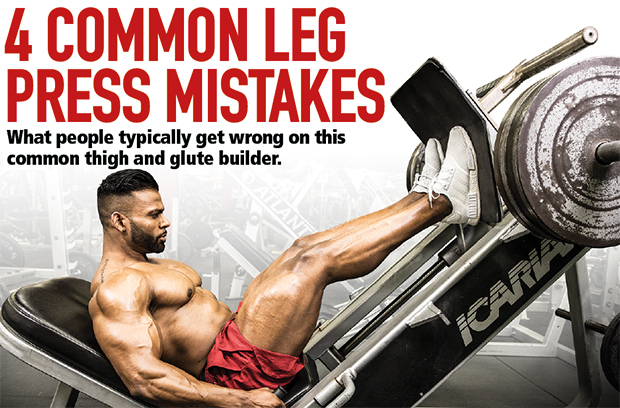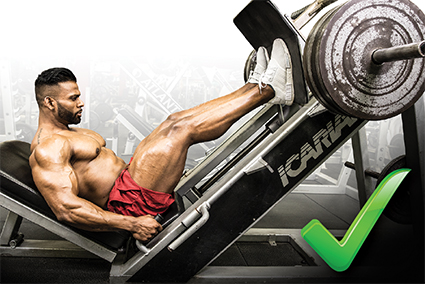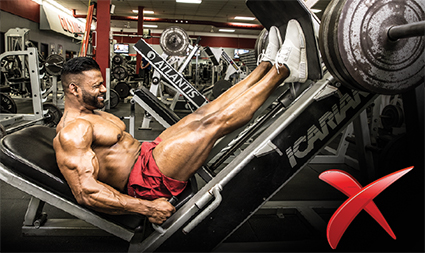4 Worst Leg Press Mistakes

You can still mess up your form on machine leg movements. Here’s what folks typically get wrong on this common thigh and glute builder.
Of all the exercises on leg day, you’d think the leg press would be just about idiot-proof. Who can mess up a sled exercise in which you just get in and push?
Plenty of folks, apparently, and in more ways than one. Let’s look at some of the common culprits on this quad and glute builder.
1. Allowing Your Heels to Come off the Sled

Whether you position your feet so low on the sled the heels are off or whether you naturally want to push through your toes – don’t laugh, I’ve seen it – the big mistake here is that you’re strongest when you push through the entirety of your foot, and that most especially includes your heels.
When your heels come off you lose not only force production, but you’re in a less stable position and are less likely to be able to control the rep. Those factors can affect the amount of weight you lift. What’s more, you’ll also experience greater sheer forces on the knee, which is especially problematic if you have pre-existing knee pain.
If you have ankle mobility limitations, reposition your feet so your entire foot remains in contact with the sled at all times and work on your flexibility.
2. Allowing the Sled to Descend Too Far

One decided advantage of the leg press is that it supports your back, taking balance out of the equation and providing greater protection against lower back rounding that’s more common in the squat. But not complete protection. Depending on your flexibility, if you lower the sled too far, your glutes can lift off the butt pad and even your lower back can come off the backpad. That puts the disks in your lumbar spine at greater risk, especially if the negative rep isn’t controlled.
Make sure you lower the sled under control at all time. Bring it down to a point just before your lower glutes lift off the seat. That’s sometimes hard to see on yourself, so get a trained spotter’s eye here. Keep the motion constricted to a safe range of motion and do post-workout stretches to ensure tight muscles don’t limit ROM. Just because you can take the sled further down doesn’t mean you should.
3. Experiencing Knee Valgus -- Your Knees Track Inward

This is more common among women but should raise a red flag telling you of increased risk of injury, especially of tears to the anterior cruciate ligament (ACL). Most commonly the culprit is weak hip abductors, including the gluteus medius.
If your knees want to track inward, start doing banded squats and leg presses, with the band placed near the top of the knees and driving your knees outward during the motion. Other good exercise choices include posterior-chain movements like deadlifts, Romanian deadlifts, single-leg Romanians, and lunges, as well as dedicated hip-abductor exercises like the hip-abductor machine (that’s the one in which you’re pushing your legs outward).
4.Locking Out Your Knees at Full Extension

We’re constantly reminding you to take your reps through a full range of motion, but there’s a fine line that separates the end of the ROM and the locked out position. That extra little bit takes tension offthe muscle and instead puts it on the joint, which in the case of the leg press can be hundreds of pounds of weight smack on the knees.
Folks who lock out are commonly looking to rest between reps,. What’s more the shift in pressure on to your knees also affects time under tension because the target muscle no longer has to be supporting the entire load. Essentially that can rob you of muscle growth.
Stop just short of locking out – about 10 degrees short if you have pre-existing knee problems – so the adjoining bones do not have maximal surface contact. It’s much harder to hold this position, which is after all the entire idea.
One further point: I’ve debated with a former boss of mine (Robert Kennedy, the publisher of MuscleMag) whether you can lock out leg extensions like you can lock out leg presses. With the former you’re never able to take the load off the muscle and shift it onto the joint at full extension. Multi-joint exercises may make the difference here.

